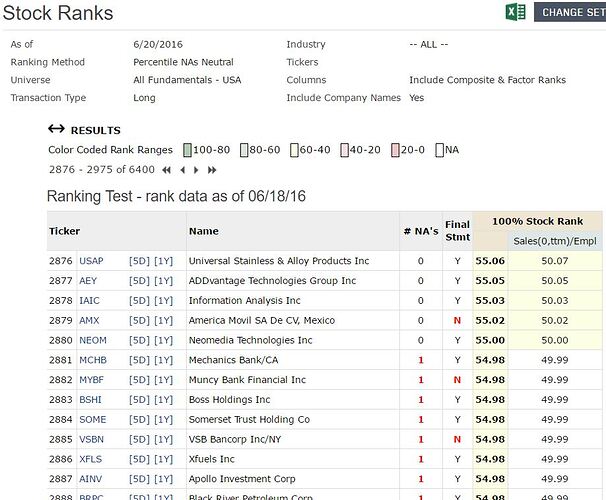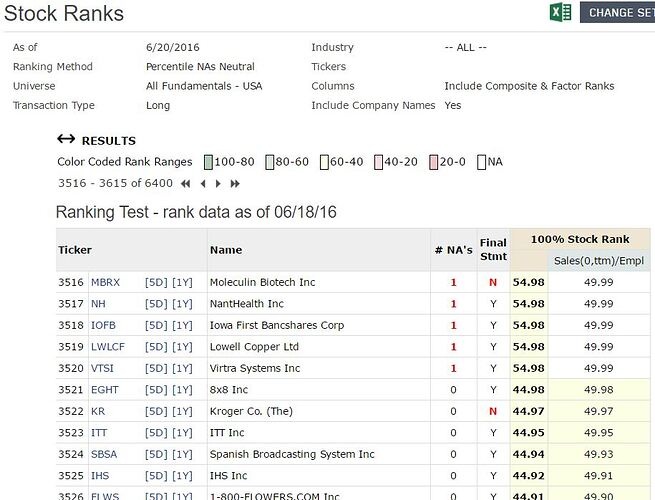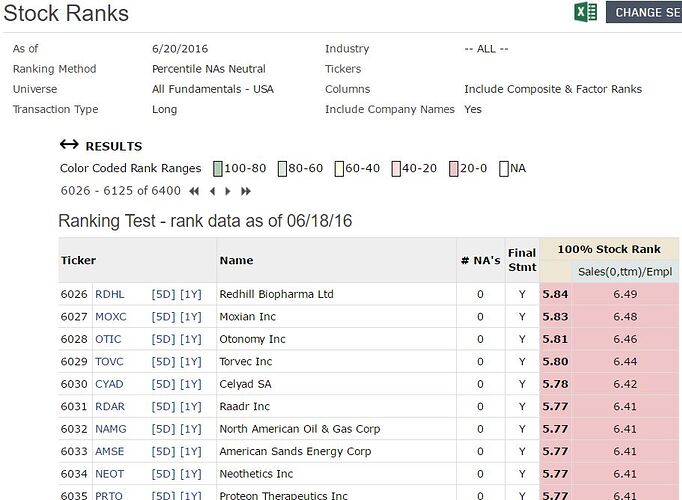I am trying to understand my ranking results for a simple ranking system:
https://www.portfolio123.com/app/ranking-system/293052
I understand that many stocks, rank 2881-3520, have a ranking value of 54.98% as NAs are set to neutral.
However, I do not understand that many stocks, rank 6031-6399, have a ranking of 5.77% immediately followed by a stock ranked 6400 with a large and sudden ranking drop to 0%. How is this sudden drop possible? Shouldn’t normalization make sure that all rank percentiles are equally distributed from 0% to 100%?
Unfortunately, reading the manual on ‘Ranking System Computation’ did not help me to understand this.
Does anyone have a clue about what’s going on here? What am I missing here?
Thanks a lot in advance!
Looking at the underlying data, there’s a few cases here:
- Positive SalesTTM, Positive Empl
- Positive SalesTTM, Missing Empl
- Zero SalesTTM, Positive Empl
- Negative SalesTTM, Positive Empl (personally, I wouldn’t invest in EVTI)
Those roughly correspond to the top band (case 1), the middle NAs (case 2), the band right below the median (case 1 again), the stuff that’s tied at the bottom (case 3, really a subset of case 1) and the bottom-most (case 4).
Thank you, but I still do not understand the ranking normalization in this case:
There are 6400 values of which 640 are NA and 369 are zero. That leaves 5393 unique values for distribution from 0 to 100%. This implies that each unique value gets ~0.02% of the total. As a result I would expect the stocks that have the second worst rating, i.e. the case 3 stocks with an underlying data value of 0, to get a normalized ranking value of ~0.02%. But in the case above they all get a value of 5.77%.
What am I missing here?
Thanks again!
When stocks are tied in a ranking system, they receive the highest possible ranking that they would have gotten otherwise.
The example that I usually use is a five stock universe where two stocks tie for second place. Those stocks will receive ranks of 100,80,80,40,20.
In this case, all of the NA neutral stocks are being placed around the median. I am usually careful to note that when you use NAs neutral, the NAs will all receive a ranking that is higher than the median because they’re tying for a value that is higher than the median.
At the bottom, you’re seeing all the zero SalesTTM stocks tying as well. You usually see that large tied chunk at the bottom with NA negative systems. In such cases, I point out that it’s handy to be able to say that there are 5.7% of the values that are NAs.
In this case it’s almost true that over five percent are getting zeros for SalesTTM (surprisingly, that appears to be pretty consistently true through time, and I did a few spot checks against CapitalIQ and yup, it’s in their database that way). It’s almost true because of EVTI.
I get it now, thanks!
But… I do not like the implications regarding the ranking of big chucks of same value data. E.g. if I would reverse the ranking system in order to create a short system, the SalesTTM=0 stocks ranked from 2-370 all get a ranking value of 99,97%. The stock coming next, i.e. ticker CYAD ranked #371, gets a ranking of 94.2% which is substantially lower and would therefore get ‘punished hard’ in a short system even though TTM sales were only $3,000.
In my opinion it would make much more sense if this stock would be ranked only one notch lower, i.e. 99.95%, instead of 369 notches lower to 94.2%.
Any suggestion on how to mitigate this issue? Z-Score? Normal NA distribution?
Again, thanks a lot!
You need something else in there to differentiate those stocks. That’s either going to be another ranking node or it’s going to be running the ranking system through a portfolio/screening rule filter.
Personally, I’d probably run it through a filter with a rule of:
SalesTTM>0
My guess is that if a company is actually running with zero (or negative!) revenues and coherent expenses in the database (which appeared to be the case when I spot checked) then it’s either a very early or very late stage company. Either way, it’s probably being valued as an option, not a stock. I would eliminate it and move on.
Thanks a lot Paul!
P.S. If someone else has some thoughts, ideas, solutions regarding this topic… they are welcome!



